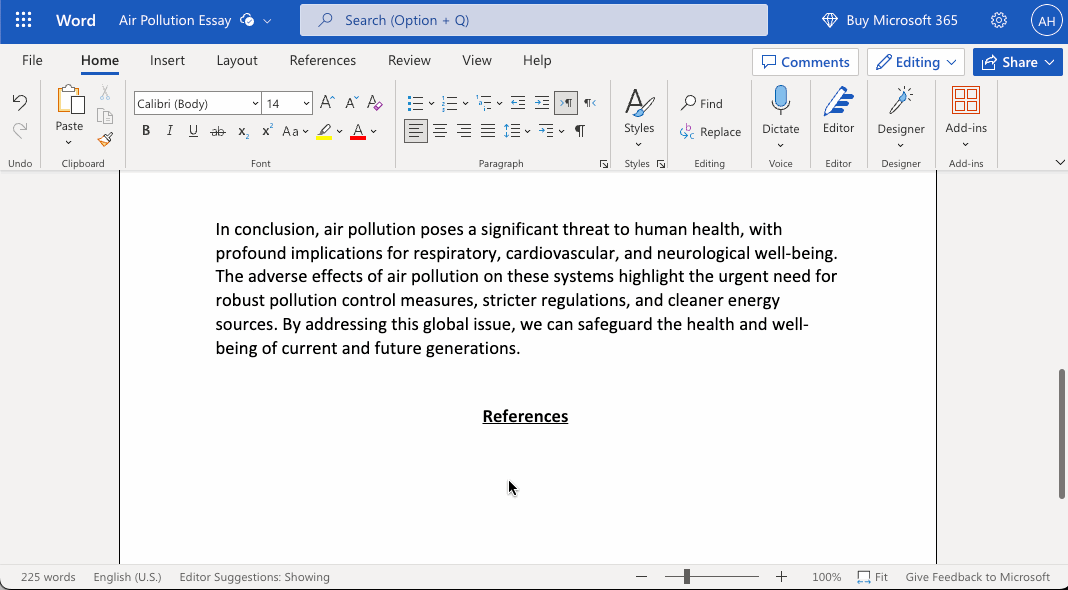APA 7th Edition Citation Format
Learn how to format a citation in the 7th edition of the APA citation style.
Navigating the world of academic writing can often seem like an attempt to decode a secret language.
One crucial component to master is the ability to cite sources correctly, providing due recognition to the original authors while avoiding any accusation of plagiarism.
One of the most widely used formats is the American Psychological Association (APA) citation style.
However, the APA citation style can seem daunting to students new to citing sources in assignments.
This article aims to provide a beginner-friendly guide to the APA 7th Edition citation format, illuminating its rules and illustrating its usage with an example.
What Are APA Citations?
Before we delve into the intricacies of the APA 7th edition, let's lay the groundwork by understanding what APA citations are.
In simple terms, APA citations are a system used to reference other people's work within your own, whether it be an essay, research paper, or dissertation.
Developed by the American Psychological Association, this citation style is most commonly used in the social sciences, including psychology, sociology, and education.
APA citation includes two components - the in-text citation, which appears within the body of your work when you refer to a source, and the reference list, a compilation of full citations of all the sources you used, presented at the end of your work.
It's like giving a roadmap to your readers to trace the origins of your research and ideas, reinforcing the credibility of your work.
Importance of APA Citations
APA citations are a cornerstone of academic integrity, and understanding their significance can greatly improve the quality of your academic writing. Here are a few reasons why APA citations are so important:
Acknowledging Original Authors
The most obvious reason for citation is to give credit where credit is due. By citing sources, you acknowledge the original authors' efforts and ideas, respecting their intellectual property rights. This acknowledgment is a fundamental principle in all scholarly work.
Verifiability of Research
Citations provide a pathway for readers to verify your research. They can look up your sources and assess the validity and reliability of your work. By providing a clear trail back to your source material, you are promoting transparency and honesty in your research.
Avoiding Plagiarism
Plagiarism, or the act of presenting someone else's work as your own, is a serious ethical violation in academic and professional settings. Proper citation practices can help you avoid plagiarism. If you use someone else's ideas, even if you paraphrase them, they must be cited to avoid any accusation of plagiarism.
Contribution to Knowledge
Citations also show how your work connects with, and contributes to, the existing body of knowledge. They illustrate the context of your work and show how it fits within the broader academic conversation. By referencing previous studies, you highlight the continuity of research and how your work expands or challenges established knowledge.
APA 7th Edition Citation Format
The APA citation format follows a general format for both in-text citations and the reference list entries. Here are the basics of each:
In-Text Citations
In-text citations appear within the body of your paper when you refer to a source. They include the author's last name and the year of publication. If directly quoting, you also include the page number.
Format:
Single author: (Author's Last Name, Year)
Reference List
The reference list appears at the end of your work and provides full citations for every source you cited. The general format varies based on the type of source but usually includes the author's name, publication year, title, and source.
Book
Here is the format (plus an example) for an APA citation when referencing a book:
Format:
Author's Last name, Initials. (Year). Title of the book. Publisher.
Example:
Doe, J. (2023). The dawn of AI. TechWorld Press.
Journal Article
Here is the format (plus an example) for an APA citation when referencing a journal article:
Format:
Author's Last name, Initials. (Year). Title of the article. Title of Journal, Volume number(Issue number), Page numbers. DOI (if available)
Example:
Smith, A. B. (2022). Exploring the future of artificial intelligence. Journal of AI Studies, 10(3), 15-30. https://doi.org/xxxx
Website
Here is the format (plus an example) for an APA citation when referencing a website:
Format:
Author's Last Name, Initials. (Year, Month Day). Title of page or document. Site Name (if different from author). URL
Example:
Doe, J. (2023, January 1). AI in 2023. TechWorld. www.techworld.com/ai-in-2023 Remember that the purpose of citation is to allow your readers to locate your sources; hence, pay attention to the accuracy of your citation details.
By understanding these formats, you can correctly reference a variety of different sources in your academic writing, adhering to the APA 7th Edition citation guidelines.
APA Citation Generator
Creating citations by hand for your assignments can be incredibly time-consuming. Instead, use a citation generator to save time and get citations much faster.

Use Text Blaze's APA citation generator for your next assignment with APA citations. With Text BLaze, you can generate APA citations in a fraction of the time it takes to do it manually.
Here's why you should use Text Blaze's APA citation generator:
It is compatible with all of your most used sites and apps such as Google Docs, Microsoft Word, Gmail, Outlook, and more.
It allows for automatic generation of APA citations for a given assignment within a matter of minutes.
Rather than copying and pasting citations, which can disrupt the formatting, Text Blaze allows you to insert them using keyboard shortcuts.
It helps you generate both full and in-text citations.
{note}To create your citation, fill out all required fields (indicated with a *) as well as any additional fields necessary.
Your citation will be created at the bottom of this form. Only the citation will be output by this snippet.
Source
{formmenu: default=book; image; journal article; online video; textbook; website; name=source}
Citation Type
{formmenu: default=Full citation; In-text citation; name=citationtype; multiple=yes}
Selecting both will output both citations at once.
Citation Details
{if: source="book" or source="textbook"}
{if: includes(citationtype, "Full citation")}Year* {formtext: name=year}{if: testregex(year, "[^0-9]")}{error: Enter numbers only}{endif}
Title* {formtext: name=title; cols=50}
Publisher* {formtext: name=publisher; cols=25}
Edition {formtext: name=edition; cols=25}
Include the ordinal indicator, such as "1st", "2nd", "3rd", or "4th"
Page(s){if: includes(citationtype, "In-text citation")}*{endif} {formtext: name=pages; cols=25}
Numbers only for a single page. Multiple pages should be separated with a - such as 10-15.
DOI {formtext: name=doi; cols=25}
ID only. Do not include https://www.doi.org/
URL {formtext: name=url; cols=50}
Include the full URL. If a DOI is included, URL will be ignored.
{elseif: includes(citationtype, "In-text citation") and not includes(citationtype, "Full citation"); trim=right}
Year* {formtext: name=year}{if: testregex(year, "[^0-9]")}{error: Enter numbers only}{endif}
Pages* {formtext: name=pages; cols=25}
Numbers only for a single page. Multiple pages should be separated with a - such as 10-15.{endif}
{elseif: source="journal article"}
{if: includes(citationtype, "Full citation")}Year* {formtext: name=year}{if: testregex(year, "[^0-9]")}{error: Enter numbers only}{endif}
Title* {formtext: name=title; cols=50}
Journal* {formtext: name=journal; cols=50}
DOI {formtext: name=doi; cols=25}
ID only. Do not include https://www.doi.org/
Volume {formtext: name=volume; cols=25}
Issue {formtext: name=issue; cols=25}
Page(s) {formtext: name=pages; cols=25}
Numbers only for a single page. Multiple pages should be separated with a - such as 10-15.
URL {formtext: name=url; cols=50}
Include the full URL. If a DOI is included, URL will be ignored
{elseif: includes(citationtype, "In-text citation") and not includes(citationtype, "Full citation"); trim=right}
Year* {formtext: name=year}{if: testregex(year, "[^0-9]")}{error: Enter numbers only}{endif}{endif}
{elseif: source="website"}
{if: includes(citationtype, "Full citation")}Title* {formtext: name=title; cols=50}
Website Name* {formtext: name=website; cols=25}
URL* {formtext: name=url; cols=50}
Include the full URL
Publishing date: {formdate: YYYY, MMMM D; name=pubdate}
Date accessed: {formdate: MMMM D, YYYY; name=accessdate}
{elseif: includes(citationtype, "In-text citation") and not includes(citationtype, "Full citation"); trim=right}
Year* {formtext: name=year}{if: testregex(year, "[^0-9]")}{error: Enter numbers only}{endif}{endif}
{elseif: source="image"}
{if: includes(citationtype, "Full citation")}Title or Description* {formtext: name=title; cols=50}
If the image has a title, use it. Otherwise, provide a description of the image [in square brackets like this].
Year* {formtext: name=year; cols=25}{if: testregex(year, "[^0-9]")}{error: Enter numbers only}{endif}
Source {formtext: name=imagesource; cols=25}
URL {formtext: name=url; cols=50}
{elseif: includes(citationtype, "In-text citation") and not includes(citationtype, "Full citation"); trim=right}
Title or Description* {formtext: name=title; cols=50}
If the image has a title, use it. Otherwise, provide a description of the image.
Year* {formtext: name=year; cols=25}{if: testregex(year, "[^0-9]")}{error: Enter numbers only}{endif}{endif}
{elseif: source="online video"}
{if: includes(citationtype, "Full citation")}Channel or Username of video publisher* {formtext: name=channel; cols=25}
Publishing date* {formdate: YYYY, MMMM D; name=pubdate}
Title* {formtext: name=title; cols=50}
Website Name* {formtext: name=website; cols=50}
URL* {formtext: name=url; cols=50}{if: includes(citationtype, "Full citation") and includes(citationtype, "In-text citation")}
Timestamp* {formtext: name=timestamp}
Provide as HH:MM:SS{endif}
Note: Listing contributors is not required for online videos. Only add below if you have this information. Check this box if you'd like to include contributors in the citation: {formtoggle: name=Include Contributors in online video citation}
{elseif: includes(citationtype, "In-text citation") and not includes(citationtype, "Full citation"); trim=right}
Channel or Username of video publisher* {formtext: name=channel; cols=25}
Publishing date* {formdate: YYYY, MMMM D; name=pubdate}
Timestamp* {formtext: name=timestamp}
Provide as HH:MM:SS
{endif}{endif}
Contributor Details
{if: (not includes(citationtype, "Full citation")) and (source="online video" or source="image")}Contributor details are not necessary for in-text citations for {=source}.{else}Number of contributors: {formmenu: default=1; 2; 3; 4; 5; name=contributors}
Contributor 1
| First Name{if: includes(citationtype, "Full citation")}*{endif} | Middle Initial | Last Name* | Suffix | Contributor Type* |
| {formtext: name=c1first; cols=15} | {formtext: name=c1mi; cols=3} | {formtext: name=c1last; cols=15} | {formtext: name=c1suff; cols=3} | {c1type="Author"}{=c1type} |
Contributor 2
| First Name{if: includes(citationtype, "Full citation")}*{endif} | Middle Initial | Last Name* | Suffix | Contributor Type* |
| {formtext: name=c2first; cols=15} | {formtext: name=c2mi; cols=3} | {formtext: name=c2last; cols=15} | {formtext: name=c2suff; cols=3} | {if: source="journal article" or source="website" or source="image" or source="online video"}{c2type="Author"}{=c2type}{else}{formmenu: Author; Editor; Translator; name=c2type}{endif} |
Contributor 3
| First Name{if: includes(citationtype, "Full citation")}*{endif} | Middle Initial | Last Name* | Suffix | Contributor Type* |
| {formtext: name=c3first; cols=15} | {formtext: name=c3mi; cols=3} | {formtext: name=c3last; cols=15} | {formtext: name=c3suff; cols=3} | {if: source="journal article" or source="website" or source="image" or source="online video"}{c3type="Author"}{=c3type}{else}{formmenu: Author; Editor; Translator; name=c3type}{endif} |
Contributor 4
| First Name{if: includes(citationtype, "Full citation")}*{endif} | Middle Initial | Last Name* | Suffix | Contributor Type* |
| {formtext: name=c4first; cols=15} | {formtext: name=c4mi; cols=3} | {formtext: name=c4last; cols=15} | {formtext: name=c4suff; cols=3} | {if: source="journal article" or source="website" or source="image" or source="online video"}{c4type="Author"}{=c4type}{else}{formmenu: Author; Editor; Translator; name=c4type}{endif} |
Contributor 5
| First Name{if: includes(citationtype, "Full citation")}*{endif} | Middle Initial | Last Name* | Suffix | Contributor Type* |
| {formtext: name=c5first; cols=15} | {formtext: name=c5mi; cols=3} | {formtext: name=c5last; cols=15} | {formtext: name=c5suff; cols=3} | {if: source="journal article" or source="website" or source="image" or source="online video"}{c5type="Author"}{=c5type}{else}{formmenu: Author; Editor; Translator; name=c5type}{endif} |
Join thousands of teams who are using Text Blaze templates.
Conclusion
Mastering the APA 7th Edition citation format might seem daunting at first, but with patience and practice, it can become second nature. Remember, the primary goal of APA citations is to acknowledge the work of others and guide your readers to the original sources.
Use Text Blaze's APA citation generator to save time while creating citations so you can focus on your assignment and, ultimately, get the grade you want.




